8 Ways NFTs & Web3 Will (Concretely) Transform Commerce & Daily Life
What are NFTs? Non-fungible tokens, while over hyped, have the potential to reshape digital commerce across music, fashion, sports and more. Here are 8 examples of how NFTs may actually become part of our daily lives.
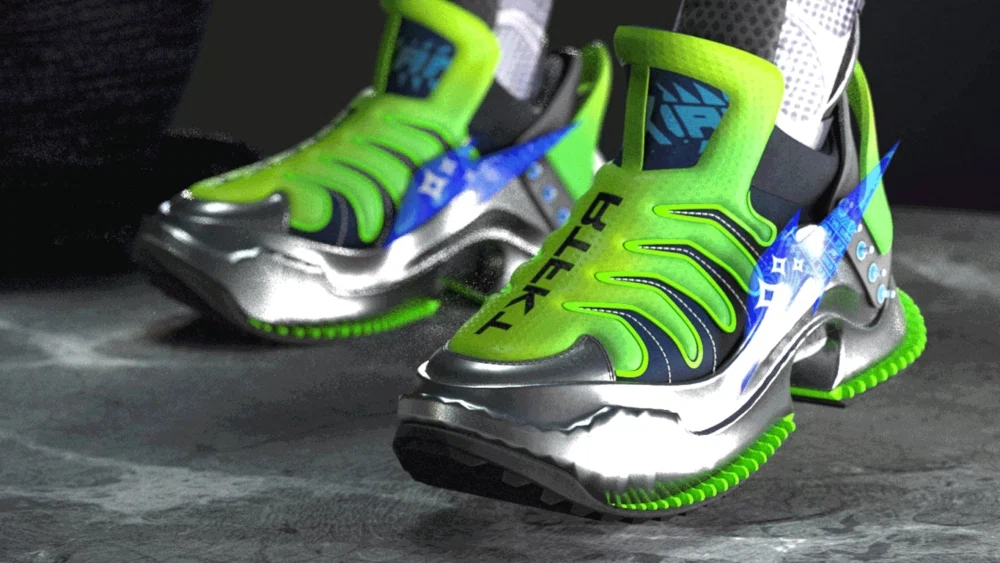
With all the buzz surrounding NFTs (and the millions of dollars being spent on JPG images and virtual cats) and web3 it's hard to know what's real or just hype.
As you peel back the layers, it becomes increasingly clear that NFTs are more than just hype. In fact, NFT technology may be new, important building block of the internet. Even in its earliest days, NFT technology is already manifesting in ways to fundamentally reshape how commerce is conducted for digital media, virtual goods, luxury assets, fashion and music. This article is an exploration of how some of these themes may play out over the next several years.
A quick definition of NFTs
In the world of cryptographic assets, there are two fundamental types: crypto-currencies (fungible tokens) and non-fungible tokens. The difference between them is their fungibility, or mutual substitutability, or more simply, their sameness. Assets on a cryptocurrency chain like Bitcoin are fungible in that every Bitcoin is the same (similar to cash). Assets on a non-fungible chain are unique - there is only one copy of each token, so think of these like ID cards or passports.
NFTs have practical, real world utility because they offer a cheap and ubiquitous way to create verification of ownership and transaction history for anything, without needing some type of trusted central authority to act as a trusted intermediary between parties. Example of these intermediaries are government records offices, escrow and title companies, and registries. NFT technology basically replaces these human intermediaries with a digital blockchain (think of it like a public digital record book) that certifies who owns what and can't be tampered or altered.
The highest price paid for an NFT to date was MetaKovan's purchase of Beeple's digital art piece titled Everydays: The First 5000 Days for $69.3 million. This shocked many because as digital art Everydays essentially is nothing more than a JPG image that anybody can freely download. Why would someone pay millions of dollars for a JPG?
The key is that MetaKovan didn't just buy any JPG copy of Everydays he bought the original JPG copy of Everydays. This original copy is verifiable through the NFT that he purchased which was minted by Christie's on an Ethereum blockchain. There is only one original Everydays, and MetaKovan owns it. NFT technology enabled this exchange of value.
This type of transaction can happen for any type of asset. NFTs simply make this process easy, cheap, and trusted. Just as the internet made web pages cheap, easy and ubiquitous, NFTs will make marketplaces cheap, easy and ubiquitous.
What NFTs are not
Blockchain technology and NFTs in particular are a confusing topic, and I've already seen a couple common misconceptions online, so let's address these first.
NFTs are not copyright
When MetaKovan purchased Everydays, it may come as a surprise that he did not receive the copyright to this art piece as a part of his purchase. As the owner of the NFT, MetaKovan simply owns a digital record proving that he owns the one and only original copy of this work. The image can still be freely downloaded on the internet, and the copyright holder can still use the work for commercial purposes.
Sure, MetaKovan could have tried to also purchase the copyright to Everydays, and that purchase would have come with a different set of rights over this work. But that would have been a different transaction.
NFT and copyright are related but separate concepts.
NFTs are not DRM
DRM (digital rights management) is a type of technology that restricts who can access various media. Amazon's Kindle service uses DRM to sell digital books and restrict access to paying users. Spotify uses DRM to enable you to download songs but not share them with non-subscribers.
Some of the buzz surrounding NFT technology seems to be that this is the blockchain era's version of DRM. That finally writers will be able to use NFTs to sell millions of ebooks.
This misunderstands what NFT technology is at its most basic level. NFTs, like all blockchains, simply provide a public record of ownership. Think of NFTs like your property deed when you buy a home. It's a public record that certifies you're the rightful owner of the home. The deed doesn't physically protect your home, it's just a document that publicly and officially authenticates you as the rightful owner of the home. You still need to install an alarm system to prevent people from stealing it from you.
NFTs are
Blockchain technology is a new, foundational internet technology that provides a mechanism to maintain a trusted, immutable public ledger of data or transactions, supported by mining, currencies and other technologies. Just like TCP/IP and HTTP enabled the new capability of web servers and web pages to create the original Internet, blockchain technologies like NFTs are coming together to enable new ways of sharing information, collaborating and transacting on the internet.
Immutable public record of ownership & transactions
NFTs create a layer of trust for any type of transaction, without the need for a third party like a government entity or even a corporation like Facebook or Google. When I sell you a digital asset as an NFT, our transaction is stored algorithmically as a public record on a public ledger called a blockchain. Our transaction is immutable - it cannot be altered in any way by anyone or any organization.
Programmable, and can enable a new type of royalty income for creators
Unlike paper certificates, NFTs are programmable. If created on a programmable blockchain like Ethereum, NFTs are more like little robots than pieces of paper - they can be programmed to do certain things based on certain inputs.
The big news in NFTs is they can be programmed to react to secondary sales in a specific way. Specifically, the original issuer of the NFT can receive a percentage of all secondary sales of the NFT. So if Beeple's Everydays is sold to another buyer, Beeple (the original issuer) can receive a royalty payment based on the size of that transaction.
This is a game changer in the world of digital assets. For the first time, scarce assets can deliver recurring revenue to their issuers.
NFTs, for the first time, introduce the concept of scarcity to digital media
Today's digital media companies are swimming upstream against of the most fundamental law of economics: supply and demand. The birth of the internet made information ubiquitous and free. In a world of infinite supply of media, regardless of the demand for such media, it's hard to charge money for it.
In music, charging for access to media has largely failed. In video, firms have seen more success, although for both video and music streaming, one could argue that in large part consumers are paying for convenience not access to media itself (which can be accessed freely through various channels). In text media, paid newsletters have seen some success, and in isolated instances news publications have seen success in building subscriber bases but this likely will be limited to a very few bellwether brands.
In the end, however, digital media has made few people rich beyond the technology companies that own and run the underlying platforms that enable discovery and consumption. For artists and creators, this is the unfortunate economic reality in a world of ubiquitously accessible bits.
What makes NFT technology so interesting is that it brings scarcity back to the equation when it comes to information and bits. This is why Everydays, a single digital image created by artist Beeple, sold for $69.3 million. By being minted as a unique NFT on a blockchain managed by Christie's, there is only a single original copy of Everydays, underscoring the immense force of the supply side of economics.
No matter how many times people create new digital copies of Everydays, only the token holder of the actual NFT can claim to own the real thing. And, in today's environment, this is apparently worth $70 million.
What we're seeing is the incredible power of bringing fundamental economics back to the equation when it comes to the internet and digital media. And we've only barely scratched the surface.
8 examples of how NFTs can reshape the digital economy and e-commerce
Music
NFTs may spell the end an era where artists have been left out of the monetization equation of digital music. Musicians will find new ways to monetize their work and their fame via NFTs.
Musicians have struggled to generate economic profit since the dawn of the internet. Music is just bits, and on the internet, bits simply prefer being free.
Digital streaming platforms (DSPs) like Spotify have grown sizable businesses, but individual artists still earn relatively paltry royalties from DSPs. In the current environment, musicians must rely on live performances to provide a viable source of income and revenue.
Consumers pay for services like Spotify not for access to music itself (which can be downloaded for free) but mostly for convenience through organizational features and device integration. As such, revenues have remained small relative to the entertainment value provided.
Recent NFT experiments by musicians paint a more hopeful picture though.
Mike Shinoda of Linkin Park recently put a piece of digital artwork called One Hundredth Stream for sale as an NFT on the crypto marketplace Zora. Here's what it looks like:
The One Hundredth Stream NFT sold on Zora for 200 WETH or $30,000. And according to Shinoda, the amount he earned from this little NFT experiment dwarfed his earnings from streaming royalties from platforms like Spotify.
Think of it like like owning a 1 of a kind item in a game, or like “owning” an instagram post. It’s a weird thing to own, yes, but: Here’s the crazy thing. Even if I upload the full version of the contained song to DSPs worldwide (which I can still do), i would never get even close to $10k, after fees by DSPs, label, marketing, etc. And reminder: the NFT isn’t the song—it’s an NFT containing the song. You can even rip the audio and video. And if the contained song becomes more popular, then arguably the NFT becomes more valuable. - Mike Shinoda
The fact that one very experimental and speculative NFT sale garnered more income to a well known artist than a months' worth of streaming revenue probably is an encouraging sign for artists. No doubt some are paying attention and I'm sure there are some interesting new, innovative NFT projects incubating across the industry right now.
Economics may be coming back as a force for good in the artist community.
Social tokens & personal tokens
NFTs provide completely new ways for celebrities (or anyone with a following) to connect with their fans and create revenue streams.
Another musician, Grammy award winning recording artist RAC, is applying NFT technology in an even more interesting way.

RAC has issued a social token, and this may represent the future of the economics of celebrity and game.
Through the Zora platform, RAC issued the social token $RAC which is a limited set of 10,000,000 shares representing himself as an artist. $RAC tokens are issued to fans based on their support for the artist. For example, his earliest supporters on Bandcamp, Patreon and Twitch were given allocations of the token, with more being distributed over time to his most loyal fans.
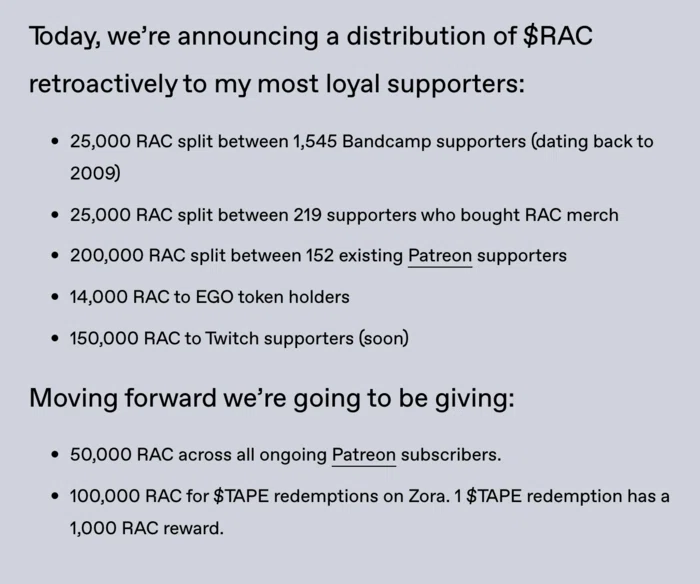
$RAC holders gain access to special perks with the artist.

$RAC is an example of how NFTs can be used as a social token, providing perks and shared economic ownership in an artist's success with their community of fans - without being bound to intermediaries who can exercise control over the community or take a portion of the economic value in fees or rent.
My hope with $RAC is to break down that barrier in-between artist and fan and collectively build a better system where we all benefit. Maybe it’s idealistic, I dunno, but the current system is fundamentally broken and we need to try something different. - RAC
You can imagine not just music artists but any celebrity or creator or even any brand with a base of fans creating similar social tokens and applying them in innovative ways to connect with, empower and reward their communities.
Luxury good trading and provenance tracking
NFT technology can create greater efficiencies in secondary markets for luxury items like handbags, watches and fine wines.
NFTs may also fundamentally reshape the luxury goods market and trading markets for items like handbags, watches, shoes and fine wines. Similar to how secondary markets like Poshmark, The RealReal and StockX have accelerated luxury goods trading, NFTs can power the next era of innovation in luxury trading by helping to address endemic problems around counterfeiting, trust and ease and cost of transactions.
One interesting example to follow is Arianee, which is trying to establish itself as the NFT platform of choice to track and secure luxury goods trading. Arianee is an Ethereum based blockchain for tracking the provenance of luxury goods and offers an NFT-based solution for tracking provenance and verification of authenticity of luxury goods.
Here's an informative video of explaining how Arianee works:
Market players like StockX the The RealReal will likely embrace NFT technology, either partnering with existing blockchains or creating their own, to secure items and create greater trust in transactions. Already luxury watch maker Breitling has created their own Ethereum blockchain to track provenance of their watches.
Other collectible markets can also find greater efficiencies using NFT technology. Take fine wine trading for example. In March 2020, seven cases of an unreleased Chateau Croix Mouton 2018 were purchased as an NFT on the WiV blockchain, making it the world's first blockchain sale of fine wine. One can imagine wine trades happening via trusted and public blockchain, while the physical assets remain securely stored by an intermediary, only shipped out when requested by an owner.
A more speculative concept which I have not yet seen discussed is whether luxury brands will begin taking a cut of secondary sales of their items through smart contracts. You could imagine LVMH programming their NFTs for each unique item they sell with a 3% royalty accruing to themselves on all subsequent sales of that item on secondary markets. This could be thought of as a sort of service fee for securing these transactions. This would create a new incentive in a recurring revenue from products which are actively sold in secondary markets and could unlock fascinating new market dynamics in luxury.
Gaming and virtual property
NFTs have the potential to unlock new economies within virtual worlds, MMOGs and online games.
Virtual games centered on collectible NFTs like CryptoKitties, Axie Infinity and Decentraland have been at the center of NFT revolution from the start, with a single CryptoKitty being purchased as an NFT for $170,000 in 2018.
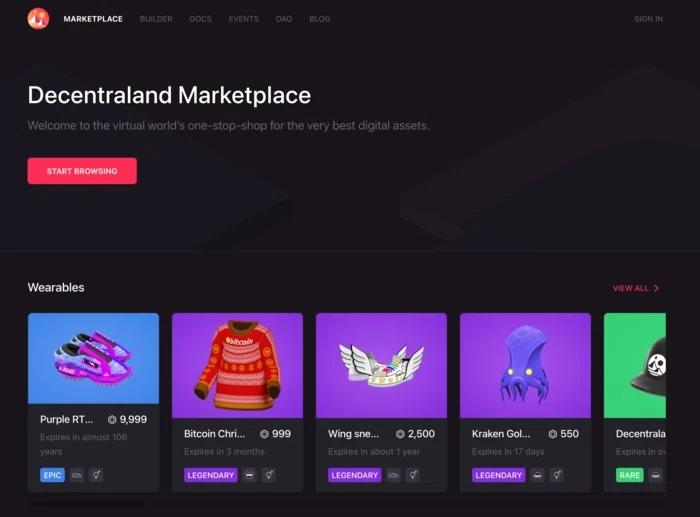
However, these niche gaming examples may seem minuscule when compared to potential impact of the mainstream virtual games and MMOGs like World of Warcraft and Runescape with their millions of players tapping into NFT technology to enable secure transaction of in-game items. In-game currencies and gold already trade for millions of dollars on secondary markets, and it's not hard to imagine limited or unique items within games with unique properties or capabilities being authenticated and traded as NFTs. One can also picture properties and homes designed and built within virtual worlds like Roblox being traded like real property using NFTs.
I think we'll see a completely new era in virtual games with integrated economics that extend into the real world, powered by blockchain technology.
Augmented reality
When A/R reaches mainstream adoption, all the NFT trends we're discussing will accelerate dramatically.
Augmented reality has yet to arrive as a viable technology, with interesting experiments to date which offer tantalizing hints at its possibilities. With Apple rumoring to be working on a high-end mixed reality headset for designers, and additional projects being worked on by Facebook, Snap and others, it's only a matter of time until we'll have practical, real world applications of A/R that become a part of daily life.
A/R has implications in gaming, art, virtual property, virtual fashion and more. Artist Jeff Koons is already famous for his augmented reality art installations, and one can imagine significant interest in owning the NFT originals of some of his most famous augmented reality art installations.

Artist Koo Jeong A's art installation Density shows as a floating cube of water in augmented reality drew praise its low environmental impact and points to a future where art installations no longer require large construction projects. Based on the success of Density, viewers can now superimpose Density in their own homes using an A/R app.

Due to their wide accessibility - anyone worldwide can experience an A/R installation in a fully immersive, high fidelity way - it seems plausible that tokenized original versions of A/R installations may eventually fetch values which rival or greatly exceed those of non-digital art.
Beyond art, applications for augmented reality in games, social media, fashion and more could benefit from NFT technology.

Unique items in Pokemon Go, one of a kind filters for Snap Spectacles, A/R outfits that can be worn virtually - you can imagine lots of A/R contexts where economic trading activity could be accelerated by NFT technology.
Sports and eSports
Digital trading cards of key moments in sports is just the beginning. NFTs may have profound impact on e-sports too.
NBA Top Shot has become a wildly popular decentralized marketplace for trading digitally-captured moments in NBA history. The site mints top plays as short video clips which users can own as an NFT, somewhat analogous to a baseball trading card. The most expensive sale to date has been a dunk by Lebron James which sold for $208,000.

While the NBA has taken the lead here, no doubt every other sport will follow suit.
eSports seems to be even more natural fit for NFTs, where top moments in competitive League of Legends, Counter Strike and Fortnite tournament play may be captured, minted and traded by fans as NFTs. Streaming platforms such as Twitch may also launch features to enable marketplaces and accelerate adoption.
Additionally, next generation eSports which introduce audience interactivity such as Formula E and drone racing also hold interesting possibilities for NFTs.
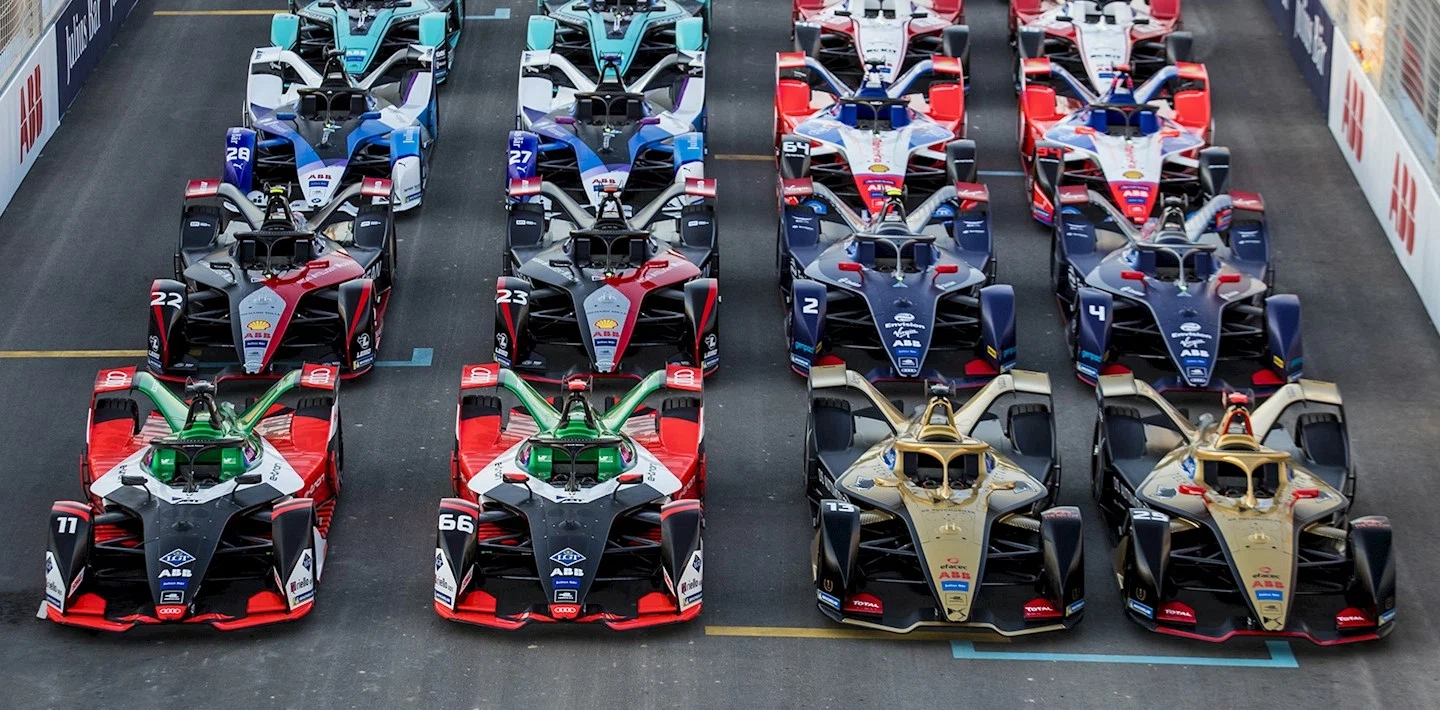
Formula E already involves audience interaction via items which can be activated to affect the race, one can imagine marketplaces for unique and valuable power ups and in-game items springing up.
Limited or unique digital items which can affect competition such as power ups or obstacles can be purchased and traded as NFTs and used within gameplay.
In fact this trend expands beyond sports - really any human activity that can involve memorable moments can be captured and resold as NFTs. One could imagine social gatherings, music performances, comedy, news worthy events, political events being a source of moments that are captured and traded as NFTs.
Fashion
In the future, most fashion items we buy will be tokenized on a blockchain and uniquely identifiable. They will also come with digital versions which interact with augmented reality and virtual worlds.
We're about to enter an era in fashion where the lines between reality and virtual will begin to blur.
The Dematerialised bills itself "the destination for digital fashion" and is a new decentralized marketplace for A/R fashion items. Watch their introductory video for a vivid visualization of how NFT technology can become part of our everyday experience in virtual fashion:
On The Dematerialised, you can acquire fashion items as NFTs. Then you can "wear" them using an A/R app on your phone, you can wear them inside various virtual games.
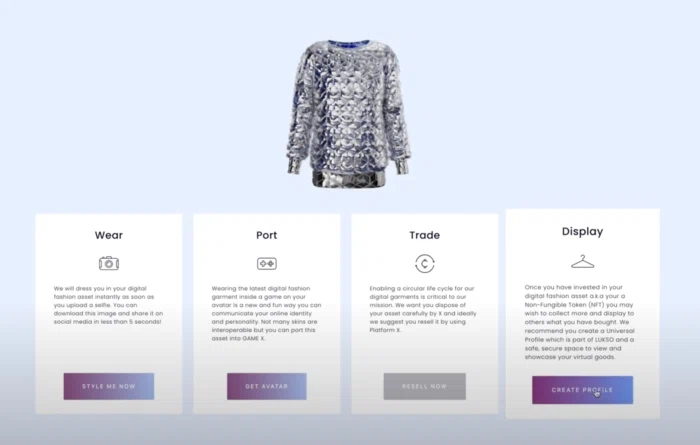
You can also superimpose your item on your own image and share it via social media.

Here's another vivid example of A/R fashion, RTFKT also created a virtual jacket called the Metajacket:
RTFKT also released a drop of virtual sneakers as NFTs which sold for a total of $3.1 million in just seven minutes.
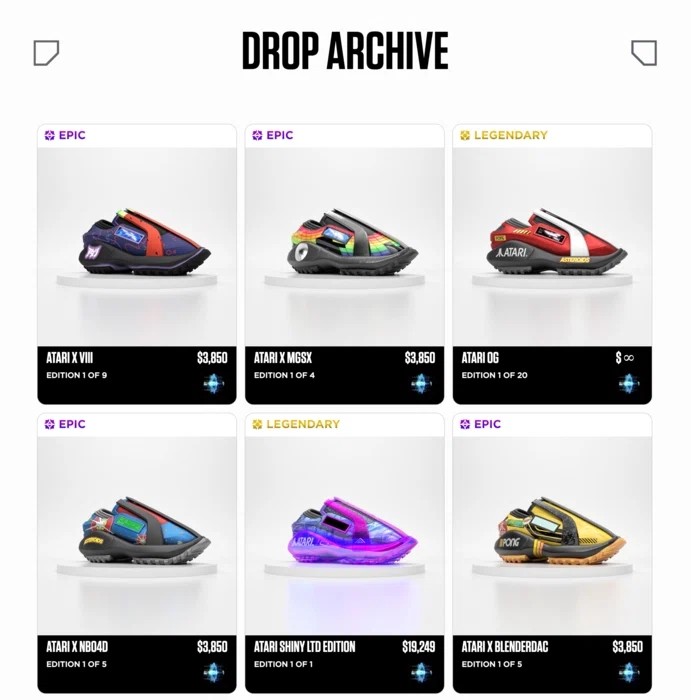
Again, these are virtual sneakers only. You can imagine Nike doing NFT drops where owners get a digital sneaker plus the real thing. Incidentally, Nike has filed a patent to launch its own cryptocurrency called CryptoKicks.
Fashion gaming app Drest enables anyone to become a virtual stylist, tapping a library of replicas of real fashion items from top designer labels like Gucci, Bottega Veneta and Prada. Users can create wardrobes and looks and compete on leaderboards, and looks on Drest are shoppable for the real items with a click.
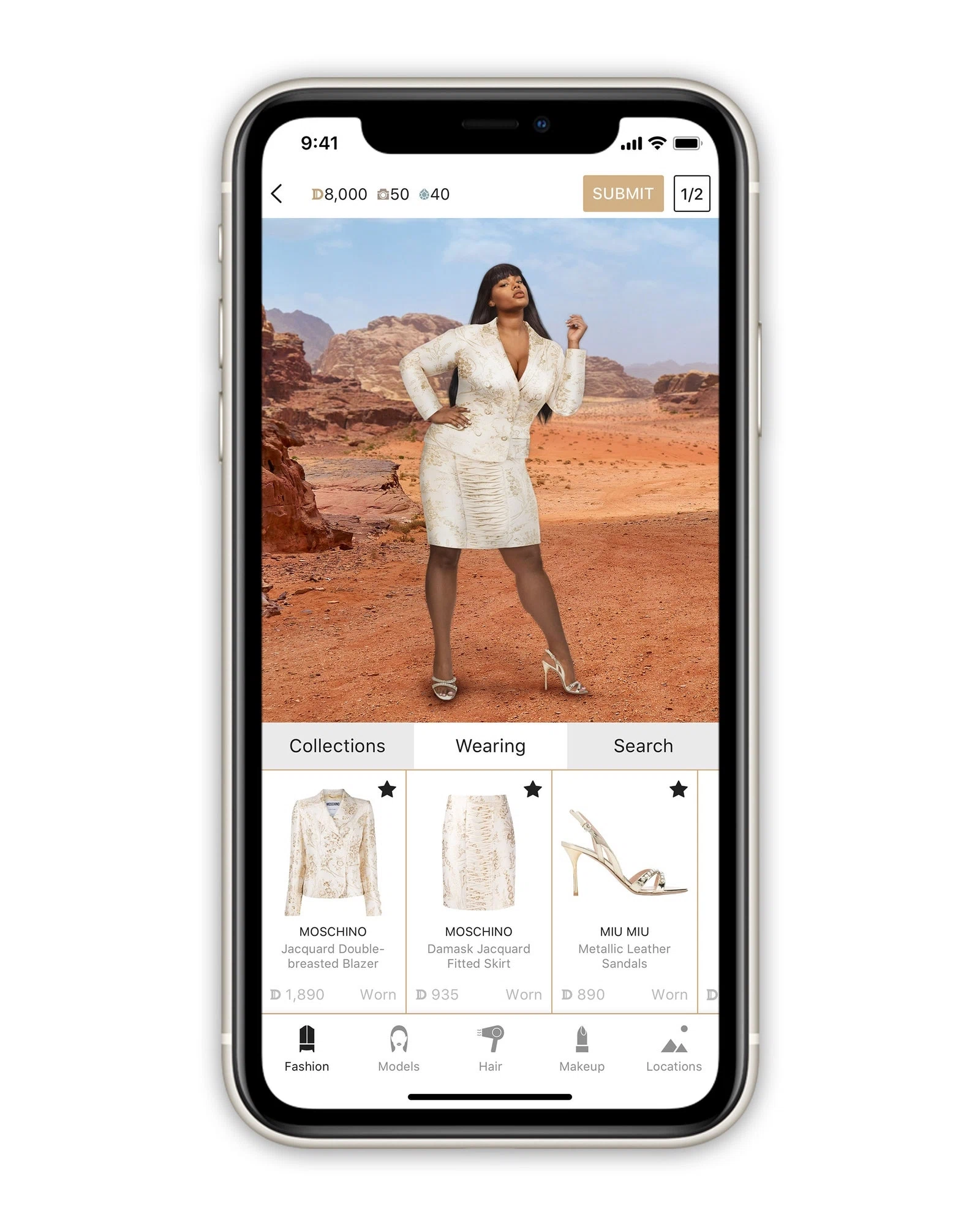
Games like Drest offer a glimpse in the future of fashion which will blur the lines between the virtual and the physical. In this new context, the type of trading activity we're imagining (NFT drops of new and limited items) can be an accelerant and economic driver.
Title ownership & transfer
NFTs will make the concept of title and ownership cheap and ubiquitous. Ownership and trading will be applied to smaller value property types, creating greater efficiencies and new markets.
Moving from the more creative to more practical applications, NFT technology may reshape our processes and philosophies around property ownership. Currently, the concept of owning property, whether a home, a car, a share of stock, a trademark or an internet domain, it usually tied to a document created and managed by a government entity, often known as a title. Titles define ownership, rights, and means of transfer.
Blockchains and NFT technology provide the same features to define ownership, rights and transfer but do it without the need for a central agency or authority to manage the process. This greatly reduces cost and makes the functionality of title ownership accessible to a whole new set of use cases. NFTs go one step further than documentary titles in that they are programmable via smart contracts, and thus can respond to inputs and behave more like applications. Secondary sale tracking and royalty streams are basic examples of this.
One very early example of this are blockchain domains. Blockchain domains replicate functionality provided by internet domains, but forgo with centralized naming authority, in this case ICANN. As smart contracts built on Ethereum, blockchain domains are also programmable and can be linked to cryptocurrency wallets. For example, I own the blockchain domain michaelquoc.crypto, which now can not only serve as a public address for a website but can also act as an addressable destination for crypto payments to me (no I'm not soliciting donations here :).
NFT technology will likely be adopted to drive newer, more innovative marketplaces enabling title transfers of various asset types, and over the very long-term be used to replace legacy infrastructure for governing real property title ownership with reduced cost and greater efficiency.
What's to come
We're in the earliest stages of experimentation and exploration with NFT technology. But I have little doubt that NFTs will over time become a core aspect of the internet and e-commerce. By publishing this article, I hope to add clarity to the discussion around NFTs and contribute to accelerating progress and innovation in this space.
As an e-commerce platform and enabler, we at Demand.io watch trends like these closely, trying to assess their impact on e-commerce overall. Decentralization, data privacy, and community will be central disruption vectors this year and over the next decade, and these will no doubt have profound impact on the way brands market and sell products, the way consumers discover and buy things, and the way creators and influencers scale their reach and businesses.
Our mission is to create the platforms of tomorrow that better connect these audiences as these new market dynamics unfold.
Follow me at @michaelquoc.